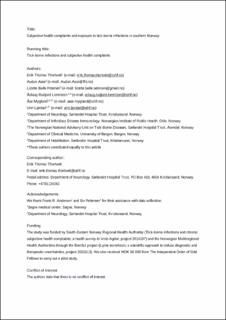Subjective health complaints and exposure to tick-borne infections in southern Norway
Thortveit, Erik Thomas; Aase, Audun; Petersen, Lizette Balle; Lorentzen, Åslaug Rudjord; Mygland, Åse; Ljøstad, Unn
Journal article, Peer reviewed
Accepted version

Åpne
Permanent lenke
https://hdl.handle.net/11250/2733143Utgivelsesdato
2020Metadata
Vis full innførselSamlinger
- Department of Clinical Medicine [2066]
- Registrations from Cristin [9791]
Sammendrag
Objectives: Whether tick‐borne infections can cause chronic subjective health complaints is heavily debated. If such a causal connection exists, one would expect to find more health complaints among individuals exposed to tick‐borne infections than among non‐exposed. In this study, we aimed to assess if exposure to tick‐borne infections earlier in life, evaluated by examination of serum for IgG antibodies to tick‐borne microbes, was associated with self‐reported somatic symptom load.
Materials & Methods: All individuals with residential address in Søgne municipality in southern Norway, aged 18‐69 years, were invited to participate in the study. Blood samples were analyzed for IgG antibodies to different tick‐borne microbes, and somatic symptom load was charted by the Patient Health Questionnaire‐15 (PHQ‐15).
Results: Out of 7424 invited individuals, 2968 (40.0%) were included in the study. We detected IgG antibodies to Borrelia burgdorferi sensu lato (Bb) in 22.9% (95% CI 21.4‐24.4). Bb seropositive individuals reported less frequently moderate to severe somatic symptom load (ie, PHQ‐15 sum score ≥ 10) than seronegative individuals (12.5% versus 17.7%, difference 5.2% [95% 2.1‐8.0]). However, when adjusting for several other variables in a multivariable linear regression model, presence of serum IgG antibodies to Bb was not associated with somatic symptom load. Presence of IgG antibodies to other tick‐borne microbes than Bb, or seropositivity to at least two microbes, was also not associated with somatic symptom load.
Conclusion: Presence of serum IgG antibodies to tick‐borne microbes was not associated with self‐reported somatic symptom load.